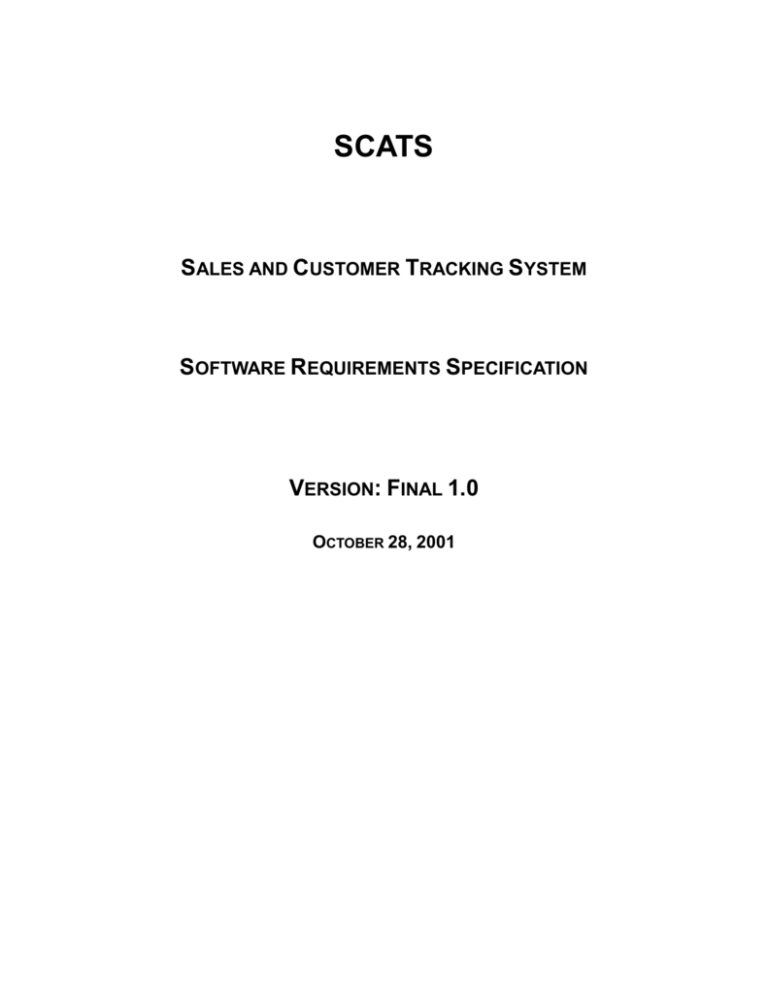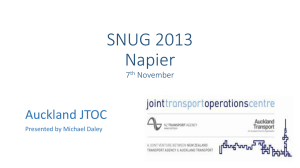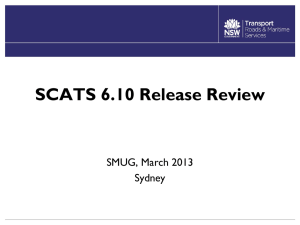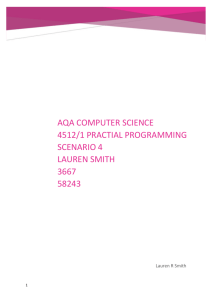Software Requirements Specification
advertisement

SCATS SALES AND CUSTOMER TRACKING SYSTEM SOFTWARE REQUIREMENTS SPECIFICATION VERSION: FINAL 1.0 OCTOBER 28, 2001 SCATS Software Requirements Specification REVISION CHART Version Primary Author(s) Description of Version Date Completed Draft Johnny Nordvik Initial draft created for distribution and review comments 10/04/01 Preliminary Johnny Nordvik Second draft incorporating initial review meeting 10/08/01 comments, distributed for final review. 10/08/01 Final 1.0 Johnny Nordvik Adding Use Case on login to system after meeting with customer 10/18/01. 10/28/01 Removing Use Case Sales Statistics after internal review 10/15/01 Reformulating the pre and post condition for each Use Case so that they match each other. First complete draft, which is placed under change control Revision 1 TBD Revised draft, revised according to the change control process and maintained under change control TBD Revision 2 TBD Revised draft, revised according to the change control process and maintained under change control TBD etc. TBD TBD TBD 106742945 (02/18/16) Page 1 SCATS Software Requirements Specification CONTENTS 1. INTRODUCTION ........................................................................................................4 1.1 1.2 1.3 1.4 1.5 PURPOSE ...................................................................................................................4 SCOPE .......................................................................................................................4 DEFINITIONS, ACRONYMS, AND ABBREVIATIONS ......................................................4 REFERENCES .............................................................................................................4 OVERVIEW ................................................................................................................4 2. OVERALL DESCRIPTION ..........................................................................................5 2.1 PRODUCT PERSPECTIVE.............................................................................................5 2.1.1 User Interfaces ........................................................................................................... 5 2.2 2.3 2.4 2.5 PRODUCT FUNCTIONS ...............................................................................................5 USER CHARACTERISTICS ...........................................................................................5 ASSUMPTIONS AND DEPENDENCIES...........................................................................5 APPORTIONING OF REQUIREMENTS ...........................................................................5 3. USER REQUIREMENT DEFINITION ...........................................................................6 4. SYSTEM ARCHITECTURE .........................................................................................6 5. SYSTEM REQUIREMENTS SPECIFICATION ...............................................................6 5.1 5.2 USE CASE DIAGRAM FOR SCATS .............................................................................6 SPECIFICATION OF ACTORS ........................................................................................7 5.2.1 5.2.2 5.2.3 5.3 SPECIFICATION OF USE CASES...................................................................................9 5.3.1 5.3.2 5.3.3 5.3.4 5.3.5 5.3.6 5.3.7 5.4 5.5 5.6 5.7 Customer..................................................................................................................... 8 Sales Manager ............................................................................................................ 8 Sales Person ............................................................................................................... 8 Use Case 1. Use Case 2. Use Case 3. Use Case 4. Use Case 5. Use Case 6. Use Case 7. Employee Registration ......................................................................... 9 Product Registration ............................................................................ 9 Sales Registration ............................................................................... 10 Customer Registration........................................................................ 11 SystemLogin ....................................................................................... 11 Update Information ............................................................................ 12 System Output ..................................................................................... 13 EXTERNAL INTERFACE REQUIREMENTS...................................................................15 PERFORMANCE REQUIREMENTS ..............................................................................15 DESIGN CONSTRAINTS ............................................................................................15 SOFTWARE SYSTEM ATTRIBUTES ............................................................................15 5.7.1 5.7.2 Security ..................................................................................................................... 15 Maintainability ......................................................................................................... 15 106742945 (02/18/16) Page 2 SCATS Software Requirements Specification 5.7.3 Portability ................................................................................................................. 16 6. SYSTEM MODELS ...................................................................................................16 7. SYSTEM EVOLUTION ..............................................................................................16 8. APPENDICES ...........................................................................................................17 106742945 (02/18/16) Page 3 SCATS Software Requirements Specification 1. INTRODUCTION 1.1 Purpose The purpose of this System Requirement Specification document is to describe the system services and constraints in detail. This document is intended for System end-users, System architects and System developers. 1.2 Scope The application to be developed is a sale and customer tracking system named SCATS. SCATS will process sales data based on data entry by users and produce sales statistics on customers and sales persons. The results can be printed. BOEC Company will through SCATS achieve the following objectives: An increase of the marked and an increase in profitability. Cost effectiveness in the use of all resources. To handle more customers. An error reduction in the handling process. An increase in flexibility and speed of activities. To have more timely information. An improvement in management planning and control. 1.3 Definitions, Acronyms, and Abbreviations SCATS Sales and Customer Tracking System UCD Use Case Diagram 1.4 References SCATS Sales and Customer Tracking System, Informal Software Specification – Version 1.0. 1.5 Overview This will be the content and organization of the rest of this document Chapter 2 will provide the overall description of the SCATS application. 106742945 (02/18/16) Page 4 SCATS Software Requirements Specification Chapter 3 will contain the User requirements for SCATS. Chapter 4 will contain the system architecture description. Chapter 5 will contain the system requirement specification. Chapter 6 will contain the domain model for SCATS. Chapter 7 will contain the system evolution description. Chapter 8 will contain appendices. 2. OVERALL DESCRIPTION 2.1 Product Perspective The SCATS application is an independent application and there are no interfaces between SCATS and related systems. 2.1.1 User Interfaces A browser will be used as a graphical user interface. In the design phase of the SCATS system, the lay out of the required screen formats, report layouts and menu structures will be decided on. 2.2 Product Functions The system will be able to register data on a sale. The system will be able to produce statistics on sales, products, sales persons and revenue. The system will be able to present the statistics on screen and on reports. 2.3 User Characteristics The users are familiar with the existing PC based spreadsheet solution. They are also familiar with Windows 98 and MS office applications through seminars and use. Beside this they have no technical expertise. 2.4 Assumptions and Dependencies Integration between SCATS an E-business solution will be developed in a later phase of the project. This will drive change in the requirements. 2.5 Apportioning of Requirements Develop the integration between SCATS and E-business solution. 106742945 (02/18/16) Page 5 SCATS Software Requirements Specification 3. USER REQUIREMENT DEFINITION The SCAT User Requirements are to be inserted here. 4. SYSTEM ARCHITECTURE SCATS will be developed on a UNIX platform. SCATS will be a distributed Java application. Communication between users and the application will be performed trough a browser. For the time being the decision on the system architecture showing the distribution of functions across system modules is yet to be taken. The final decision on the system architecture will be made in the design phase of the project. 5. SYSTEM REQUIREMENTS SPECIFICATION This section will describe the functional and non-functional requirements at a sufficient level of detail for the designers to design a system satisfying the User requirements and testes to verify that the system satisfies the requirements. The system requirements will be developed through object oriented analysis and design methods by the use of UML model language. All system requirements will be uniquely identifiable. 5.1 Use Case Diagram for SCATS The figure shows the Use Case Diagram (UCD) for SCATS. The UCD is developed as a part of the analysis phase of the system development process. This diagram might be changed during later stages in the development process. 106742945 (02/18/16) Page 6 SCATS Software Requirements Specification 5.2 Specification of actors The following actors are defined so far in the analysis phase of the SCATS system development process. 106742945 (02/18/16) Page 7 SCATS Software Requirements Specification 5.2.1 Customer Customer Element Details Description A Customer is a client of the BOEC business. This can be an individual or a company. Examples A Customer buys products and pay cash. A Customer buys products on credit and pay after a period of time. 5.2.2 Sales Manager Sales Manager Element Details Description Sales Manager is the person in the sales department who oversees the sales activity. Examples The Sales manager is allowed to update all information in the system. Also his/her own information. Only the Sales Manager can register new products and new Sales Persons. The Sales Manager can also make a sale to a customer. 5.2.3 Sales Person Sales Person Element Details Description The Sales Person is the person that interacts with the Customers and makes sales. Examples A Customer shows up at BOEC and buys some products from the Sales Person. A Sales Person will also answer a telephone call from Customer and make a sale. 106742945 (02/18/16) Page 8 SCATS Software Requirements Specification 5.3 Specification of Use Cases 5.3.1 Use Case 1. Employee Registration EmployeeRegistration Element Details Actor Sales Manager Trigger The Sales Manager needs to register an new employee Pre Conditions The employee is not registered, the user is logged into the system, and the system menu is displayed. Post Conditions The employee is registered and has a username and password, the user is logged into the system, and the system menu is displayed. Normal course 1. The Sales Manager collects employees’ data 2. The Sales Manager creates a new user account 3. The Sales Manager defines username and password 4. The employee is given a user name and password Alternative courses 3a. The user name already exists. 3a1. Create a different user name. 5.3.2 Use Case 2. Product Registration ProductRegistration Element Details Actor Sales Manager Trigger The supplier have delivered the new product Pre Conditions The product is not in the stock, the user is logged into the system, and the system menu is displayed. Post Conditions The product is in the stock, the user is logged into the system, and the system menu is displayed. Normal Event Flow 1. The sales manager open the product registration form by choosing the menu item for this action 2. Sales Manager registers all necessary information about the product in the system. 3. Sales Manager update the System by confirming the data entered into the registration form. 106742945 (02/18/16) Page 9 SCATS Software Requirements Specification ProductRegistration Element Variations Details 3a. Mandatory fields in the registration form are missing 3a1. The system reject the system update with an error message about missing mandatory fields. 5.3.3 Use Case 3. Sales Registration SalesRegistration Element Details Actor Customer, Sales Manager, Sales Person Trigger Customer wants to buy something Pre Conditions The product is in the stock, the user is logged into the system, and the system menu is displayed. Post Conditions The sale is registered, the inventory is updated, the user is logged into the system, and the system menu is displayed. Normal event flow 1. Customer asks for product 2. Sales Person looks for a product in the system 3. Sales Person updates the system 4. The system calculate the total of the invoice (product * quantity) Variations 2a.The product is not in the stock 2a1.The system informs that the product is not available 3a.The system cannot update the product 3a1.Check manually, make manually sale and report to Sales Manager Relevant information 106742945 (02/18/16) Questionnaires or Answers should be in text, choice boxes, or different alternatives Page 10 SCATS Software Requirements Specification 5.3.4 Use Case 4. Customer Registration CustomerRegistration Element Details Actor Sales Person, Sales Manager Trigger Customer is not registered in the System and the user wish to register a sale. Pre Conditions Customer’s ID is not listed in the system, the user is logged into the system, and the system menu is displayed. Post Conditions Customer is registered in the system, the user is logged into the system, and the system menu is displayed. Normal course 1. Registration form appears on the screen 2. System increment the last registered Customer ID by 1 to get the ID for the new Customer. 3. Sales Person or Sales Manager fill in the Customer’s information including Name, Adress(es), Phone number(s), E-mail(s), Contact person 4. System update Alternative courses 3a. Not all mandatory data fields are filled 3a1.Sales Person or Sales Manager fills in the missing data fields 5.3.5 Use Case 5. SystemLogin SystemLogin Element Details Actor Sales Manager, Sales Person Trigger The user wish to start using the system. Pre Conditions The user is not logged into the system. Post Conditions The user is logged into the system, and the system menu is displayed. Normal course 1. The user click the link for the SCATS application and a login form appear on the screen. 2. The user types his username and password into the form and press the login button. 3. The system confirms that the user is logged on. 106742945 (02/18/16) Page 11 SCATS Software Requirements Specification SystemLogin Element Alternative courses Details 2a. The user is not a valid user or the user name or the password is mistyped. 2a1. The system reject login with an error message that express wrong login name or password. 5.3.6 Use Case 6. Update Information UpdateInformation Element Details Actor Sales Manager, Sales Person Trigger Sales Manager or Sales Person is noticed by manually routines that one or several data in system are outdated, false or are missing. Pre Conditions System contains outdated, false or are missing data, the user is logged into the system, and the system menu is displayed. Post Conditions The system contains valid and updated data, the user is logged into the system, and the system menu is displayed. Normal course 1. Sales person or Sales Manager opens relevant input form from menu. ( Update Customer, Update Product Update Sales Person Information ) 2. Sales Person or Sales Manager correct or fills in missing information. 3. Sales person or Sales Manager closes the form and the system is updated. 1a Sales Person try to update own sales information data. Alternative courses 1a1 Only Sales Manager is allowed to update sales information for a Sales Person. 1a2 System rejects action from Sales Person with an error message. 1b Sales Person try to update information on other Sales Person or on Sales Manager 1b1 Sales Person is not allowed to update information on other users. 121 System rejects action from Sales Person with an error message. 106742945 (02/18/16) Page 12 SCATS Software Requirements Specification 5.3.7 Use Case 7. System Output SystemOutput Element Details Actor Sales Person, Sales Manager Trigger The Sales Person or Sales Manager asks for a presentation of statistical data of products, sales customers or Sales Persons. Pre Conditions The user is logged into the system, and the system menu is displayed. Post Conditions A report is displayed in a part of the browser window or is printed out on paper. The user is logged into the system, and the system menu is displayed. 106742945 (02/18/16) Page 13 SCATS Software Requirements Specification Normal course 1. The Sales Person or the Sales Manager chooses between the menu choices Customers, Sales Persons, Products or Statistics from an on screen menu. 2. If the Customers menu choice is chosen a menu containing the alternatives All Customers and Specific Customer appears on screen. 3. If the All Customer menu choice is chosen, an alphabetically sorted list of all customers is displayed. 4. IF the Specific Customer menu choice is chosen the user must input the Customer ID to retrieve all data about the customer. 5. If the Sales Persons menu choice is chosen an alphabetically sorted list containing the names of the Sales Persons is displayed. 6. If the Products menu choice is chosen a menu containing the alternatives All Products and Specific Product is displayed on screen. 7. If the All Products menu choice is chosen, an alphabetically sorted list containing all the products is displayed. 8. If the Specific Product menu choice is chosen, the user must input the product number to retrieve all data about the product, included the stock inventory for the product. 9. If the Statistics menu choice is chosen a menu containing the alternatives Sales Person Historical Data, Total Largest Revenue, Best Sales Person, Most Sold Product and Less Sold Product. 10. If the Sales Person Historical Data is menu choice is chosen, the user must enter the values from date and to date to be able to list all the sales, belonging to the user, he has closed between these two dates 11. If the Total Largest Revenue menu choice is chosen, a list containing the Sales Persons and their total sales revenuer is displayed as long as the user is a Sales Manager. 12. If the Best Sales Person menu choice is chosen, the user must enter the ID of the product and a list containing the Sales Persons and their revenue for the specified product in descending order is displayed as long as the user is a Sales Manager. 13. If the Most Sold Product menu choice is chosen, the user must enter the values from date and to date to be able to list the most sold products and their total revenue between the two dates, as long as the user is a Sales Manager. 14. If the Less Sold Product menu choice is chosen, the user must enter the values from date and to date to be able to list the less sold products and their total revenue between the two dates, as long as the user is a Sales Manager. 106742945 (02/18/16) Page 14 SCATS Software Requirements Specification Alternative courses 4a A non existing customer ID is entered into the system 4a1 An error message is displayed and return to 2. 8a A non existing product ID is entered into the system 8a1 An error message is displayed and return to 6. 11a The user is not a System Manager. 11a1. An error message is displayed and return to 1. 12a The user is not a System Manager. 12a1. An error message is displayed and return to 1. 13a The user is not a System Manager. 13a1. An error message is displayed and return to 1. 14a The user is not a System Manager. 14a1. An error message is displayed and return to 1. 5.4 External Interface Requirements This section will contain specification on the layout of the user interface. This design is to be decided upon later in the project timeline. 5.5 Performance Requirements No performance requirements are specified in the User requirements. 5.6 Design Constraints The SCATS application will be developed according to an incremental process model. An object oriented analysis and design will be used as a method in the process. 5.7 Software System Attributes 5.7.1 Security All users will have access to the SCATS application restricted by a logon containing ID and password. There will be activity logging by updating a log-file containing the fields ( ID, timestamp, success/failure ). 5.7.2 Maintainability As a tool to obtain the ease of maintainability the CASE-tool Tau_UML will be used in the development process. 106742945 (02/18/16) Page 15 SCATS Software Requirements Specification 5.7.3 Portability To ensure portability, the SCATS application will be developed in JAVA language. 6. SYSTEM MODELS The figure shows the System model expressed as an object model in the analysis phase of the development process. 7. SYSTEM EVOLUTION 106742945 (02/18/16) Page 16 SCATS Software Requirements Specification The SCATS application is developed in Java. This is believed to assure platform independence for the application. 8. APPENDICES No appendices. 106742945 (02/18/16) Page 17






